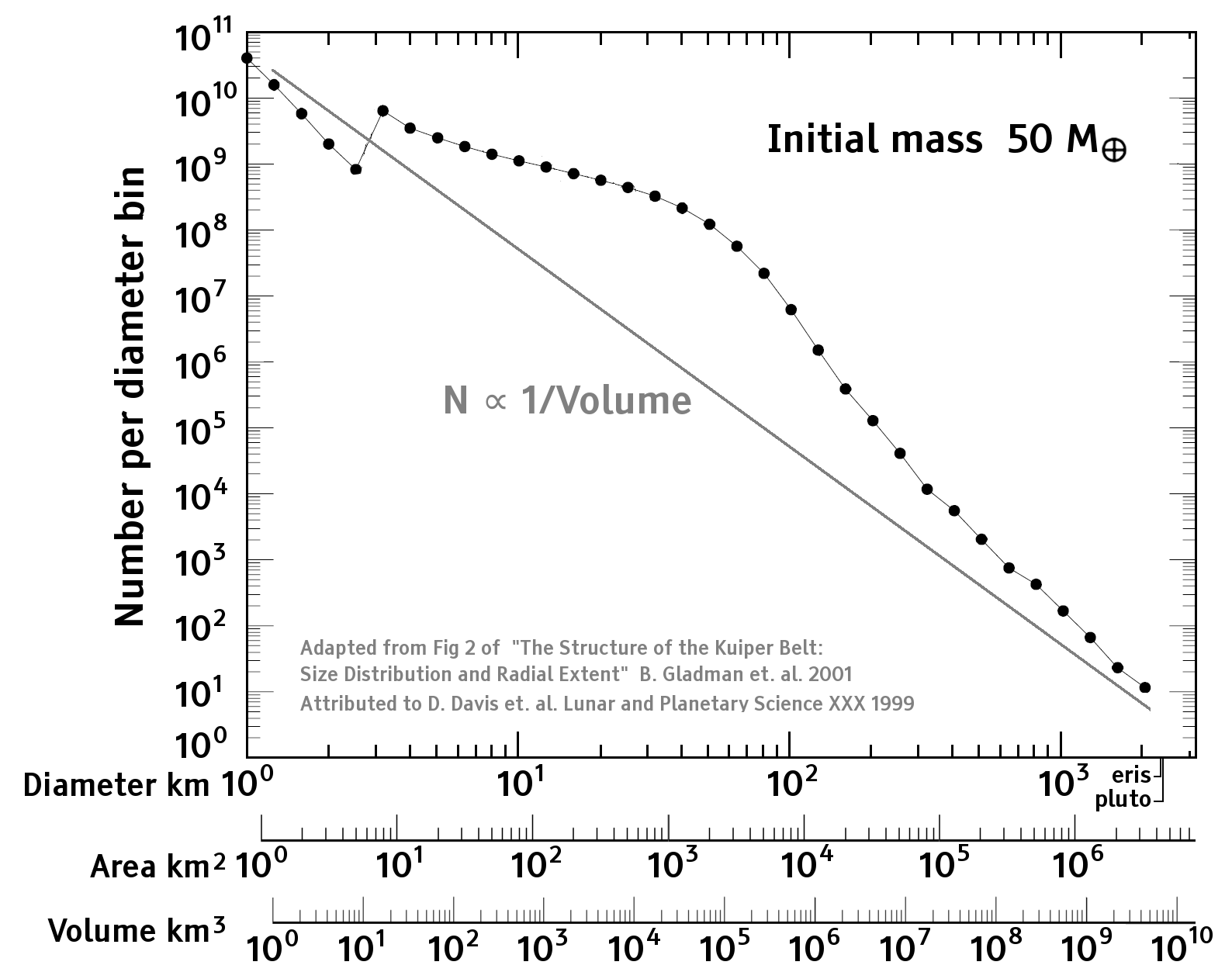KuiperBelt
The Structure of the Kuiper Belt: Size Distribution and Radial Extent, Brett Gladman et. al. |
Bottom of page 1065: The disk mass in the observed region out to ≈60 AU is ≈0.1 Mearth (6e23 kg), only weakly dependent on the roll-over size and radial distribution.
The Kuiper belt starts at approximately 30 AU; most is too difficult to observe.
The characteristic light pressure mass density Mλ ( kg/m² ) is L⊙ / 4π c μ⊙ = 3.846e26 / 4 π 2.99792e8 * 1.32712e20 = 7.45e-4 g/m². A perfect front-side IR filtering back-side emissive thinsat masses 1/3 of that, 2.48e-4 g/m². Assume some imperfections, 3e-4 kg/m².
A 3e-4 kg/m², 50 AU Dyson shell ( 7.46e12 m, 7e26 m², g⊙ = 2.38e-6 m/s² ) uses 2.1e23 kg of ice and other materials. Presume we use 10% of that as reaction mass, 2.1e22 kg, total 2.3e22 kg and use the other 3.7e22 as a reserve. As the sun heats up over the next few billion years, the shell must move further out to stay cool, and the light pressure will increase, so more ice must be mined from the Oort cloud and other ice bodies passing the solar system to continuously add to the mass of the shell.
|
Pluto |
Eris |
MakeMake |
|
Aphelion AU |
49.3 |
97.7 |
52.8 |
|
Perihelion AU |
29.7 |
38.6 |
37.9 |
|
Semimajor Axis AU |
39.5 |
68.1 |
45.3 |
|
Angular vel. ω rad/s |
8.05e-10 |
3.56e-10 |
6.56e-10 |
|
Eccentricity e |
0.245 |
0.434 |
0.164 |
|
Velocity vo m/s |
4895 |
4010 |
4490 |
|
Aphelion Velocity m/s |
3932 |
2796 |
3857 |
|
Perihelion V m/s |
6843 |
7085 |
5370 |
|
Orbital period Gsec |
7.82 |
17.6 |
9.75 |
|
Inclination degrees |
17.4 |
44.04 |
29 |
|
Radius km |
1190 |
1163 |
715 |
|
Mass kg |
1.3e22 |
1.66e22 |
|
|
Mass Earths |
0.0022 |
0.0028 |
|
|
Density g/cm³ |
1.84 |
2.52 |
|
|
Escape velocity m/s |
1210 |
1380 |
|
|
Gravity m/s² |
0.62 |
0.82 |
|
|
Core pressure GPa |
0.7 |
1.2 |
|
WAG |
Rotation period sec |
5.52e5 |
|
|
|
Rotation speed m/s |
13 |
|
|
|
Axial tilt degrees |
120 |
|
|
- Challenger Deep 110 MPa, Earth core 350 GPa, Jupiter 4 TPa, Sun 30 PPa
- Carbon Fiber 1 GPa compression at 300K, 60% better at LN2 temperature

